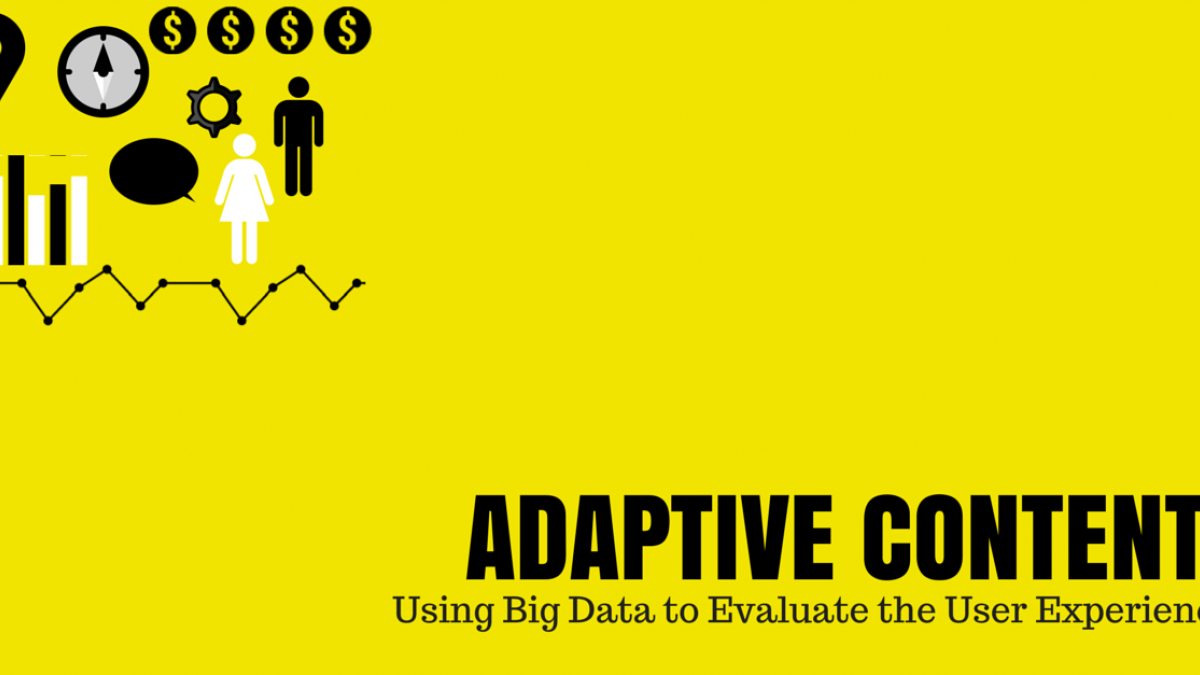
Adaptive Content: Using Big Data to Evaluate the User Experience
Not so very long ago, a website was a website and that was that. No matter who you were, where you logged on from, or whether or not you’d been there before, the experience was the same, visit after visit after visit.
Then we started getting better at tracking data and using it to customize the experience — think Amazon’s recommendation engine or the ability to include recipient names in your emails. Enter personalization.
Then along came mobile devices, and we started to see the cracks in this “one size fits all” model. Enter responsive design.
Now get ready for the next phase of the customized online experience: adaptive content.
What Is Adaptive Content?
As is the case with most new concepts, the definitions of adaptive content are as diverse as authors writing about it. That said, we’re partial to this summary by Noz Urbina:
Adaptive content is a content strategy technique designed to support meaningful, personalized interactions across all channels. It is content that is conceived, planned and developed around the customers: their context, their mood, their goals. This definition isn’t device- (or even technology-) specific. Adaptive content can cover all content, on all channels.
In other words, adaptive content (1) takes everything we’ve done up to this point to tailor the user experience and (2) combines it with the latest big data capabilities to (3) create something totally unprecedented.
Why Adaptive Content, and Why Now?
“Well, now wait a minute. We’ve been doing just fine with personalization and responsive design — why the heck do we need to change again?”
The good news is, if your content strategy has been keeping up with the growing demand for a more user-focused experience, you’re already well on your way to building an adaptive content model.
So, why is it that we’re revisiting this issue again, this time with a fancy new buzzword and a new set of expectations?
Reason #1: It’s a Jungle Out There
Let’s face it — with nearly 1 billion websites out there, each trying to get its share of shrinking audience attention spans, we need every advantage we can get.
And with users firmly in control, the key to our success — our survival, even — is keeping them happy. Really, really happy. We’re not going to do that with coupons, daily deals, or frequent-buyer programs. We’re going to do that by delivering a remarkable user experience that’s tailor-made for them.
Reason #2: Mobile Nation Is Growing … in Size and in Purchasing Power
It’s no secret that mobile’s share of the Web is growing fast, with some studies showing that it now accounts for as much as 60 percent of Internet traffic. But who are these mobile users? What are they looking for in an online experience — and how do they buy?
Today we know more about mobile users than ever before. Check out these stats from a recent Google study:
- 88 percent of users who look up local information on their smartphones take action within a day.
- Nine out of ten smartphones searches results in an action (purchasing, visiting a business, etc.).
- 74 percent of smartphone shoppers make a purchase, whether online, in-store or on their phones.
Think it might be worth the effort to offer these folks an outstanding user experience? Thought so.
And what if we don’t? A study from Compuware revealed that 46 percent of users will not return to a site if they have a disappointing experience — and 57 will not recommend the site to others.
Reason #3: Experience Drives Results
Sure, happy users are more likely to return to your site and maybe even recommend it … but are they more likely to buy?
Indeed, they are — so much so that industry experts are pointing out the rise of the “me-tail” phenomenon. As SAP’s Rajat Matta and Rae Leyshon put forth in a recent blog post:
The Me-tail phenomenon has seen an uptrend with the customers’ capability to research, read reviews and receive advice, and then purchases products / services utilizing many touch points including company websites, mobiles and tablets, social media and stores. The entire retail ecosystem has been affected by consumers’ use of both digital and physical shopping channels to make their purchase decisions, often using several channels to buy just one item. While these touch points enable faster dissemination of information from the retailers to the customers, and make the transactions faster and smoother, they also make it easier for the customer to move away from the retailers’ website due to a bad customer experience or if someone else offers a better one.
So, Where Do We Start?
While the whole concept of adaptive content is still taking shape, there are some initial steps that can help you get on track:
- Nail down your buyer personas. If you haven’t looked at them in a while, now is the perfect time to review and revise … and fill in any gaps you may find. Remember to go beyond simple demographics and take into account their values, their challenges, and their online habits.
- Know your buyer’s journey. Make sure you and your team understand how buyers get from the “just browsing” phase all the way through the purchase and beyond … and that your content management system accommodates them at each stage.
- Evaluate your channels. Are you using an email, social media, your website and other channels as effectively as possible to serve each buyer persona at each stage of their journey?
- Evaluate your formats. Look at how you’re using text, video, podcasts, infographics, and other formats to advance each persona to the next level of the buyer journey. What adjustments can you make to speak to each buyer’s needs at each level of the experience?
How are you and your team upping your game to create an adaptive content model? Share your insights with us in the comments!

